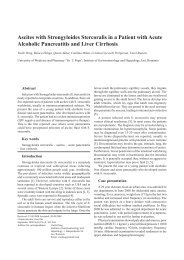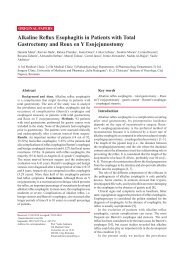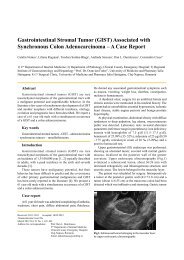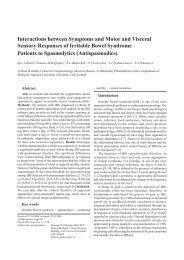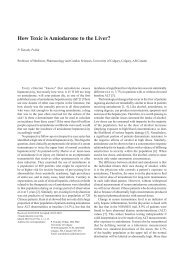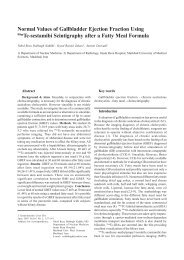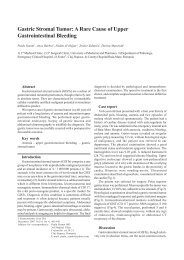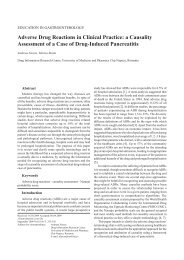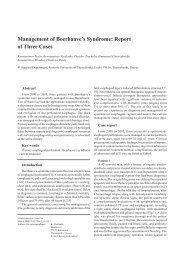Glycogen Storage Disease Type I - Journal of Gastrointestinal and ...
Glycogen Storage Disease Type I - Journal of Gastrointestinal and ...
Glycogen Storage Disease Type I - Journal of Gastrointestinal and ...
You also want an ePaper? Increase the reach of your titles
YUMPU automatically turns print PDFs into web optimized ePapers that Google loves.
<strong>Glycogen</strong> storage disease type I<br />
<strong>Glycogen</strong> <strong>Storage</strong> <strong>Disease</strong> <strong>Type</strong> I - between Chronic Ambulatory<br />
Follow-up <strong>and</strong> Pediatric Emergency<br />
Evelina Moraru 1 , Oana Cuvinciuc 1 , Luiza Antonesei 1 , Doina Mihãilã 2 , Laura Bozomitu 3 , Tania Rusu 1 , Bogdan Stana 1 ,<br />
Paula Sacaci 1 , Ana Luchian 1 , Livia Bratu 5 , Alice Popescu 4 , Ozkan Mircan 3 , Dan Moraru 3<br />
1) 2 nd Clinic <strong>of</strong> Pediatrics. 2) Morphopathology Laboratory. 3) 3 rd Clinic <strong>of</strong> Pediatrics. 4) Pediatrics Outpatient Clinic, “Sf.<br />
Maria” Emergency Hospital for Children, Iasi. 5) Private Outpatient Clinic, Roman<br />
Abstract<br />
Background <strong>and</strong> aims. To describe the characteristics<br />
<strong>of</strong> patients with type I glycogenosis, the presentation types,<br />
the main clinical signs, the diagnostic criterias <strong>and</strong> also the<br />
disease outcomes on long term follow-up. Methods. The<br />
study group consisted <strong>of</strong> 6 patients (medium age 3 years 6<br />
months) admitted in hospital between 2001 <strong>and</strong> 2005 <strong>and</strong><br />
followed-up for 1 to 5 years. The sex ratio was 1:1. Results.<br />
The referral reasons varied from hepatomegaly incidentally<br />
discovered (3 <strong>of</strong> 6 patients) to abdominal pain (4 <strong>of</strong> 6<br />
patients), growth failure (3 <strong>of</strong> 6 patients), symptoms <strong>of</strong><br />
hypoglycemia (3 <strong>of</strong> 6 patients), recurrent epistaxis (1 patient).<br />
Hepatomegaly was present in all cases. Biological pr<strong>of</strong>ile:<br />
hypoglycemia, increased transaminase values, hypertriglyceridemia,<br />
lactic acidosis, normal uric acid levels. Two<br />
patients had neutropenia <strong>and</strong> other two had increased<br />
glomerular filtration rate. Liver biopsy showed glycogenladen<br />
hepatocytes <strong>and</strong> markedly increased fat. Four patients<br />
had type Ia <strong>and</strong> 2 patients type Ib glycogenosis. The therapy<br />
consisted <strong>of</strong>: diet, ursodeoxycholic acid, granulocyte<br />
colony-stimulating factor, broad spectrum antibiotics for<br />
those with type Ib glycogenosis. The follow-up parameters<br />
were clinical, biological, imaging. Metabolic interventions<br />
<strong>and</strong> antiinfectious therapy were necessary. All patients are<br />
alive, two <strong>of</strong> them on the waiting list for liver transplantation.<br />
Conclusions. <strong>Glycogen</strong> storage disease type I is a rare<br />
condition, but with possible life-threatening consequences.<br />
It has to be kept in mind whenever important hepatomegaly<br />
<strong>and</strong>/or hypoglycemia are present.<br />
Key words<br />
<strong>Glycogen</strong> storage disease type I - hypoglycemia -<br />
children - hepatomegaly<br />
J Gastrointestin Liver Dis<br />
March 2007 Vol.16 No 1, 47-51<br />
Address for correspondence: Pr<strong>of</strong>. Evelina Moraru<br />
Spitalul de Urgenþã pt.Copii<br />
“Sf. Maria”<br />
Str. Vasile Lupu 62<br />
Iaºi, Romania<br />
E-mail: emoraru@iasi.mednet.ro<br />
Introduction<br />
<strong>Glycogen</strong> storage disease type I (GSD I) is part <strong>of</strong> a rare<br />
group <strong>of</strong> inherited diseases characterized by enzyme defects<br />
that affect the glycogen synthesis <strong>and</strong> degradation cycle.<br />
GSD I is more appropriately considered a defect in<br />
gluconeogenesis, as the enzyme defect blocks the formation<br />
<strong>of</strong> glucose not only from glycogen stores, but also from<br />
glucose precursors (lactate, aminoacids) (1). There are two<br />
subtypes <strong>of</strong> type I glycogen storage disease, both having<br />
autosomal recessive transmission: type Ia is the most<br />
common, characterized by a defect in glucose-6-phosphatase<br />
(an enzyme found only in the liver, kidney <strong>and</strong><br />
intestinal mucosa) activity, <strong>and</strong> type Ib, caused by a defect<br />
in microsomal transport <strong>of</strong> glucose-6-phosphate (2). Given<br />
the fact that there are no newborn screening programs for<br />
this disorder, there are no reliable estimates for the incidence<br />
<strong>of</strong> GSD I, but it is unlikely that it occurs more frequently<br />
than 1 case in 100 000 infants (3). Besides the clinical findings<br />
<strong>of</strong> massive hepatomegaly, enlarged kidneys <strong>and</strong> growth<br />
failure, the biologic picture <strong>of</strong> GSD I is very complex,<br />
characterized by hypoglycemia, lactic acidosis, hyperlipidemia,<br />
moderate increase in transaminase levels,<br />
hyperuricemia, <strong>and</strong> also neutropenia or neutrophil<br />
dysfunction in type Ib GSD. The hepatic <strong>and</strong> renal injury is<br />
chronic, emphasizing the need for long-term follow-up.<br />
There is a high variability in the course <strong>of</strong> the disease,<br />
including the possibility <strong>of</strong> hepato-carcinoma, making<br />
therapeutic decisions vary from simple dietary measures to<br />
liver or hepatocyte transplantation (4). Life expectancy in<br />
GSD-1 has improved considerably. Its relative rarity implies<br />
that no metabolic centre has experience <strong>of</strong> a large series <strong>of</strong><br />
patients. Experience with long-term management <strong>and</strong> followup<br />
at each centre is limited (5).<br />
The aims <strong>of</strong> this study are to establish the characteristics<br />
<strong>of</strong> patients with GSD I, to describe the presentation types<br />
<strong>and</strong> the main clinical signs, to evaluate the diagnostic<br />
criterias (clinical, biological <strong>and</strong> histological) <strong>and</strong> also the<br />
disease outcomes regarding growth, liver function <strong>and</strong><br />
metabolic pr<strong>of</strong>ile on long term follow-up. The importance <strong>of</strong><br />
establishing practical guidelines for long term follow-up is
48<br />
Moraru et al<br />
emphasized by the serious <strong>and</strong> potential life-threatening<br />
complications <strong>of</strong> the disease.<br />
Material <strong>and</strong> methods<br />
The study group consisted <strong>of</strong> 6 patients aged 1 year 3<br />
months to 6 years 5 months (mean age 3 years 6 months) at<br />
diagnosis, admitted in our clinic between 2001 <strong>and</strong> 2006 <strong>and</strong><br />
periodically reevaluated for 1 to 5 years. The sex ratio was<br />
1:1. There was no consanguinity <strong>of</strong> the parents <strong>of</strong> these<br />
children, nor was there any known shared pedigree between<br />
the 6 cases, all <strong>of</strong> whom lived in different regions <strong>of</strong><br />
Moldavia.<br />
The inclusion criterias were:<br />
1. clinical: hepatomegaly; growth failure; no muscular<br />
symptoms <strong>and</strong> signs;<br />
2. biological: hypoglycemia early in fasting (3-4 hours<br />
after meals); normal insulin / glycemia ratio; little or no<br />
glycemic response to glucagon; lactic acidosis; normal<br />
values <strong>of</strong> creatinine kinase;<br />
3. histological: markedly increased fat <strong>and</strong> glycogen in<br />
hepatocytes.<br />
Results<br />
The clinical information for each <strong>of</strong> the 6 cases is shown<br />
in Table I.<br />
The first presentation in our clinic was due to different<br />
reasons. Two patients were referred for investigation <strong>of</strong> a<br />
hepatomegaly incidentally discovered at physical<br />
examination in the context <strong>of</strong> an acute pathologic condition.<br />
The other patients referred as follows: abdominal pain<br />
accompanied by increased abdominal girth (Fig.1) (4 cases),<br />
growth failure (3 cases), symptoms <strong>of</strong> hypoglycemia with<br />
early morning awakenings for feeding <strong>and</strong> an increased<br />
appetite, episodes <strong>of</strong> fatigue <strong>and</strong> decreased energy that<br />
improved after feeding, unexplained somnolence, sweating<br />
(2 cases), recurrent epistaxis (1 case). Two <strong>of</strong> the cases had<br />
a positive history <strong>of</strong> frequent bacterial infections (recurrent<br />
mouth ulcers, otitides, boils, pneumonias).<br />
The physical findings constantly included hepatomegaly<br />
<strong>of</strong> different degrees, from moderate to massive, with a liver<br />
Table I Clinical information for cases 1 – 6<br />
Fig.1 Case 3: female, 2 yrs 1 month old, dolllike<br />
facies, short stature, increased abdominal<br />
girth, liver span 18 cm.<br />
span between 14 <strong>and</strong> 22 cm. In five cases the patients had<br />
doll-like facies (Fig.1), four patients had growth failure, four<br />
patients had excessive sweating, <strong>and</strong> two had ketotic breath.<br />
The hematological parameters showed mild irondeficiency<br />
anemia in three cases <strong>and</strong> moderate neutropenia<br />
in the two cases associated with frequent bacterial infections<br />
(cases 4 <strong>and</strong> 6).<br />
The serum biochemical pr<strong>of</strong>iles <strong>of</strong> the 6 children are<br />
summarized in Table II. All <strong>of</strong> them had elevated liver<br />
transaminase levels, although <strong>of</strong> varying severity.<br />
Case Age at Sex Reason for referral Physical findings<br />
diagnosis<br />
1 15 mo F asymptomatic hepatomegaly Liver span 14 cm, ketotic breath<br />
incidentally discovered<br />
2 19 mo M Suspected recurrent hypoglycemia; Liver span 16 cm, doll-like facies,<br />
increased abdominal girth, abdominal pain ketotic breath<br />
3 2 yr 1 mo F Asymptomatic hepatomegaly incidentally Liver span 18 cm, doll-like facies,<br />
discovered.<br />
short stature<br />
4 4 yr 10 mo F Short stature; increased abdominal girth, Liver span 18 cm, doll-like facies, short stature<br />
abdominal pain<br />
5 4 yr 10 mo M Short stature, increased abdominal girth, Liver span 22 cm, doll-like facies, short stature<br />
abdominal pain, recurrent epistaxis<br />
6 6 yr 5 mo M Suspected recurrent hypoglycemia; Liver span 20 cm, doll-like facies, short stature
<strong>Glycogen</strong> storage disease type I 49<br />
Table II Serum biochemical pr<strong>of</strong>ile on presentation<br />
Case Fasting ALP, U/L AST, U/L ALT, U/L GGT, U/L Total Cholesterol Triglycerides<br />
glucose bilirubin (120 – 230 (20-130<br />
mg/dl) mg/dl)<br />
1 0.28 g/l X1.5 NV X 6 NV X 5 NV N N 268 340<br />
2 0.45 g/l N X 4 NV X 5 NV N N 327 280<br />
3 0.33 g/l N X 12 NV X 11 NV X 4 NV N 339 1100<br />
4 0.42 g/l N X 5 NV X 4 NV X 2 NV N 275 570<br />
5 0.38 g/l N X 2 NV X 3 NV N N 324 740<br />
6 0.44 g/l N X 3 NV X 3 NV N N 306 620<br />
ALP alkaline phosphatase, AST aspartate aminotransferase, ALT alanin aminotransferase, GGT gammaglutamyl transpeptidase, NV<br />
normal value<br />
R<strong>and</strong>om blood glucose levels varied between severe<br />
hypoglycemia <strong>and</strong> normal values, <strong>and</strong> the glycemic pr<strong>of</strong>ile<br />
correlated to feeding schedule showed the occurrence <strong>of</strong><br />
hypoglycemia within 3 to 4 hours after meals in all cases.<br />
The patients underwent fasting challenges that were<br />
concurrent with these findings. The oral glucose tolerance<br />
test showed inappropriate (small) glycemic rise in all cases.<br />
We assessed the insulin levels, correlated to the glycemia<br />
values, finding low levels <strong>of</strong> insulinemia <strong>and</strong> appropriate<br />
values <strong>of</strong> insulin/glycemia ratios in all cases. The glucagon<br />
test showed a glycemia rise <strong>of</strong> 15 – 25 % in two cases, <strong>and</strong><br />
no glycemic response in 4 cases. This helped us to<br />
distinguish GSD I from GSD III, in which patients <strong>of</strong>ten<br />
have an increased serum glucose after glucagon<br />
administration, with the exception <strong>of</strong> prolonged fasting, when<br />
patients with GSD III lose their ability to respond to<br />
glucagon. Having no access to enzymatic diagnosis in our<br />
country, those analyses have been strong arguments for<br />
the clinical type <strong>of</strong> GSD. The results <strong>of</strong> the fasting challenges<br />
are shown in Table III.<br />
Table III Results <strong>of</strong> initial fasting challenge<br />
Time to Fasting challenge Time to<br />
Case hypogly- Glucagon response lactic<br />
cemia in fed state acidosis<br />
1 3.0 Negative Positive<br />
2 3.5 Negative Positive<br />
3 3.5 Negative Positive<br />
4 4 Glycemia rise <strong>of</strong> 15% Positive<br />
5 3 Negative Positive<br />
6 3.5 Glycemia rise <strong>of</strong> 25% Positive<br />
In the evaluation protocol we included the assessment<br />
<strong>of</strong> hypoglycemia consequences on the central nervous<br />
system. Clinically, all patients were within normal for age<br />
regarding psychomotor development. The EEG showed no<br />
changes consistent with brain damage. The psychological<br />
evaluation was also normal.<br />
Imaging studies consisted <strong>of</strong> ultrasonographic<br />
evaluation <strong>and</strong> CT scan. Ultrasonography showed marked<br />
homogeneous hepatomegaly with intense hyperechogenicity,<br />
no splenic abnormalities; the kidneys were enlarged<br />
in three cases (age between 4 <strong>and</strong> 7 years), all <strong>of</strong> them also<br />
having increased glomerular filtration rate. There were no<br />
signs <strong>of</strong> portal hypertension in any <strong>of</strong> the cases. The CT<br />
scan was performed in 3 cases, showing massive<br />
homogeneous enlargement <strong>of</strong> the liver, with low contrast<br />
enhancement.<br />
Three cases had delayed bone maturation.<br />
The percutaneous liver biopsy showed glycogen-laden<br />
hepatocytes in PAS staining in all cases, establishing the<br />
diagnosis <strong>of</strong> GSD (Fig.2). Sudan stain showed markedly<br />
increased fat in the liver. There was no evidence <strong>of</strong> fibrosis<br />
in the liver tissue. The bone marrow showed no pathologic<br />
elements in any <strong>of</strong> the cases.<br />
The association <strong>of</strong> massive liver enlargement, rapid onset<br />
<strong>of</strong> hypoglycemia 3 to 4 hours after meals, elevated lactic<br />
acid levels <strong>and</strong> marked hypertriglyceridemia was considered<br />
sufficient to establish the diagnosis <strong>of</strong> GSD Ia in four cases,<br />
The triglyceride values were elevated in all cases but at<br />
different degrees: 200 – 500 mg/dl in 2 cases, 500 – 1000 mg/<br />
dl in 3 cases, <strong>and</strong> more than 1000 mg/dl in one case, accompanied<br />
by prolonged bleeding time due to impaired platelet<br />
function as a consequence <strong>of</strong> hypertriglyceridemia (1).<br />
Uric acid levels were normal at diagnosis in all patients.<br />
The lactate levels increased dramatically with hypoglycemia<br />
<strong>and</strong> glucagon administration <strong>and</strong> decreased following<br />
administration <strong>of</strong> glucose. Ketosis was quantified in urine<br />
at 1+ in 4 cases <strong>and</strong> 2+ in 2 cases. Four <strong>of</strong> the patients (cases<br />
3-6) had increased glomerular filtration rate, with normal<br />
blood urea nitrogen. The youngest patients had no evidence<br />
<strong>of</strong> renal involvement at admission.<br />
Fig.2 Case 3: Liver tissue, optic microscopy: glycogen laden<br />
hepatocytes (PAS stain).
50<br />
<strong>and</strong> Ib in those two cases associated with frequent bacterial<br />
infections <strong>and</strong> neutropenia (cases 4 <strong>and</strong> 6) (1,21,22). In these<br />
two cases, although they had no suggestive symptoms, we<br />
performed also colonoscopy <strong>and</strong> colonic mucous biopsies<br />
to identify the eventual changes consistent with inflammatory<br />
bowel disease that is <strong>of</strong>ten associated with glycogen<br />
storage disease type Ib (6,7,22). We found no such changes.<br />
Therapeutic approach<br />
The mainstay <strong>of</strong> therapy in all cases consisted <strong>of</strong> dietary<br />
measures including a pattern <strong>of</strong> frequent carbohydrate<br />
feedings; administration <strong>of</strong> 2 g/kg <strong>of</strong> uncooked cornstarch<br />
suspensions (1,8,9,20) every 6 hours was effective in<br />
avoiding hypoglycemia symptoms in all children. However,<br />
during follow-up, in spite <strong>of</strong> this measure, there were still<br />
low glycemic values in the morning, but no accompanying<br />
symptoms.<br />
Data about the development <strong>of</strong> premature atherosclerosis<br />
in young adult GSD I patients are very scarce. Even though<br />
in familial hypercholesterolemia or familial combined<br />
hyperlipidemia, a comparable degree <strong>of</strong> hyperlipidemia is<br />
associated with cardiovascular morbidity <strong>and</strong> mortality at<br />
early age, studies showed that GSD type Ia is not associated<br />
with premature atherosclerosis, despite the longst<strong>and</strong>ing<br />
dyslipidaemia <strong>and</strong> microalbuminuria (10). Little is known<br />
about possible vascular protective mechanisms against the<br />
dyslipidaemia in GSD Ia. The diminished platelet aggregation<br />
(11) can be only partly protective (12). Recently, a decreased<br />
susceptibility <strong>of</strong> in vitro oxidation <strong>of</strong> VLDL cholesterol has<br />
been found (13). The renal deleterious effects <strong>of</strong><br />
dyslipidaemia are, however, an argument for lipid-lowering<br />
measures, including drug treatment (14,15,20). We<br />
considered it prudent to advise our patients to avoid high<br />
lipid intake, <strong>and</strong> we recommended omega-3 fatty acids<br />
supplements (fish oil) for their effect <strong>of</strong> decreasing<br />
triglycerides <strong>and</strong> VLDL levels in hypertriglyceridemic<br />
subjects, with a concomitant increase in HDL. Omega-3 fatty<br />
acids lower plasma triglycerides by inhibiting VLDL <strong>and</strong><br />
apolipoprotein B-100 (16) synthesis, <strong>and</strong> in conjunction with<br />
transcription factors, target the genes governing cellular<br />
triglyceride production <strong>and</strong> those activating oxidation <strong>of</strong><br />
excess fatty acids in the liver. Inhibition <strong>of</strong> fatty acid<br />
synthesis <strong>and</strong> increased fatty acid catabolism reduce the<br />
amount <strong>of</strong> substrate available for triglyceride production<br />
(17). We also recommended dietary restrictions on fructose<br />
<strong>and</strong> galactose <strong>and</strong> supplemented the diet with calcium <strong>and</strong><br />
multivitamins (1).<br />
All patients received treatment with ursodeoxycholic<br />
acid (15 mg/kg body weight) for its hepatoprotective effects<br />
<strong>and</strong> its intervention in cholesterol metabolism.<br />
Those patients with type Ib GSD received also broad<br />
spectrum antibiotics, <strong>and</strong> one <strong>of</strong> them received granulocyte<br />
colony-stimulating factor (GCSF) 5 μg/kg twice per week for<br />
a period <strong>of</strong> two years, <strong>and</strong> the median neutrophil counts<br />
increased significantly to normal values <strong>and</strong> simultaneously<br />
there was a slight decrease in median leukocyte <strong>and</strong> platelet<br />
Moraru et al<br />
counts, <strong>and</strong> the number <strong>and</strong> severity <strong>of</strong> infections decreased.<br />
As a complication <strong>of</strong> the treatment, a mild splenomegaly<br />
occurred.<br />
Evolution during follow-up<br />
The patients were followed-up in our clinic for a period<br />
<strong>of</strong> 1 to 5 years. The follow-up parameters were clinical (the<br />
amount <strong>of</strong> catch-up growth under appropriate carbohydrate<br />
supplementation, the liver span, psychological evaluation),<br />
biological (neutrophil count, glycemic pr<strong>of</strong>ile, transaminase<br />
levels, lipid pr<strong>of</strong>ile, uric acid levels, renal function<br />
parameters), imaging (for early detection <strong>of</strong> focal hepatic<br />
lesions <strong>and</strong> renal changes).<br />
One <strong>of</strong> the four patients with short stature had a<br />
satisfactory growth rate, reaching normal values for age<br />
after two years <strong>of</strong> treatment. The other three patients<br />
remained under normal values for age. Cases 1 <strong>and</strong> 2 that<br />
showed normal values <strong>of</strong> the anthropometric measurements<br />
for age at diagnosis also had a satisfactory growth rate.<br />
Liver span decreased in four cases by 10-15 % <strong>and</strong> increased<br />
by 10-15% in the other two cases. There were no signs <strong>of</strong><br />
brain damage or any deterioration in cognitive functions or<br />
delay in psychomotor achievements.<br />
Despite the dietary measures, there was poor control <strong>of</strong><br />
the glycemic values in cases 2 <strong>and</strong> 3, with frequent moderate<br />
hypoglycemia during the night <strong>and</strong> in the morning<br />
accompanied by sweating, tremor, irritability/apathy. In the<br />
other 4 cases there was good glycemia control, with rare<br />
episodes <strong>of</strong> hypoglycemia accompanying acute diseases<br />
with low oral intake that required intravenous glucose<br />
support <strong>and</strong> prompt metabolic intervention until resolution.<br />
Transaminase levels remained moderately to mildly<br />
increased, with the exception <strong>of</strong> case 3 that maintained moderate<br />
to high levels for a period <strong>of</strong> one year <strong>of</strong> follow-up<br />
(Fig3).<br />
Fig.3 Transaminase values during follow-up.<br />
Cholesterol <strong>and</strong> triglyceride values normalized in case 1<br />
<strong>and</strong> remained slightly to moderately increased in the other 4<br />
cases.<br />
Uric acid was high after 3 <strong>and</strong> 4 years, respectively, in<br />
cases 3 <strong>and</strong> 2, <strong>and</strong> normal in all the other cases. We used<br />
allopurinol 10 mg/kg/day divided in three doses.
<strong>Glycogen</strong> storage disease type I 51<br />
There were no signs <strong>of</strong> renal function impairment in any<br />
<strong>of</strong> the patients during follow-up, <strong>and</strong> case 2 showed also<br />
renal enlargement <strong>and</strong> high glomerular filtration rate after 3<br />
years <strong>of</strong> follow-up.<br />
Ultrasonographic evaluation was performed during<br />
every check-up (18) <strong>and</strong> there were no focal liver changes<br />
suggestive for adenoma or hepatocellular carcinoma.<br />
Because <strong>of</strong> the massive hepatomegaly accompanied by<br />
poor glycemic control, cases 2 <strong>and</strong> 3 are on the waiting list<br />
for liver transplantation (20-22).<br />
As a new hope for the etiologic treatment <strong>of</strong> the disease,<br />
recent data <strong>of</strong> genetic research on animal models<br />
demonstrated that a single administration <strong>of</strong> a recombinant<br />
adenovirus vector can alleviate the clinical manifestations<br />
<strong>of</strong> GSD type Ia, suggesting that this disorder in humans can<br />
potentially be corrected by gene therapy (19).<br />
Conclusions<br />
<strong>Glycogen</strong> storage disease type I is a rare condition, but<br />
it has to be kept in mind for differential diagnosis whenever<br />
confronted with hepatomegaly <strong>and</strong>/or hypoglycemia. It is<br />
important to look for hypoglycemia even in the absence <strong>of</strong><br />
suggestive clinical signs, as the high levels <strong>of</strong> lactate can<br />
serve as an alternative fuel for the brain.<br />
The pr<strong>of</strong>ound alteration <strong>of</strong> carbohydrate homeostasis<br />
with its consequences on acid-base balance can lead to lifethreatening<br />
situations that need prompt metabolic<br />
intervention; patients with GSD type Ib require special<br />
attention because <strong>of</strong> the high risk <strong>of</strong> sepsis.<br />
Long term complications <strong>of</strong> GSD type I require complete<br />
periodic reevaluation.<br />
Hepatic transplantation is indicated in cases in which<br />
there is no sufficient metabolic control, in children who<br />
develop multiple adenomas <strong>and</strong> when hepatomegaly is<br />
massive.<br />
References<br />
1. Stanley CA. Disorders <strong>of</strong> Carbohydrate Metabolism. In: Pediatric<br />
<strong>Gastrointestinal</strong> <strong>Disease</strong>. Pathophysiology, Diagnosis,<br />
Management. Walker WA, Durie PR, Hamilton JR et al eds.<br />
3rd ed, BC Decker Inc., Hamilton, ON 2000: 1064-1069.<br />
2. Chen YT. The Metabolic <strong>and</strong> Molecular Bases <strong>of</strong> Inherited<br />
<strong>Disease</strong>. Vol 1. New York, NY: McGraw Hill; 2001: 1521-<br />
1551.<br />
3. Chou JY, Matern D, Mansfield BC, Chen YT. <strong>Type</strong> I glycogen<br />
storage diseases: disorders <strong>of</strong> the glucose-6-phosphatase<br />
complex. Curr Mol Med 2002;2:121-143.<br />
4. Matern D, Starzl TE, Arnaout W, et al. Liver transplantation<br />
for glycogen storage disease types I, III, <strong>and</strong> IV. Eur J Pediatr<br />
1999; 158 Suppl 2: S43-48<br />
5. Visser G, Rake JP, Labrune P et al. Consensus guidelines for<br />
management <strong>of</strong> glycogen storage disease type 1b - European<br />
Study on <strong>Glycogen</strong> <strong>Storage</strong> <strong>Disease</strong> <strong>Type</strong> 1. Eur J Pediatr.<br />
2002;161 Suppl 1:S120-3<br />
6. Melis D, Parenti G, Della Casa R, et al. Crohn’s-like ileo-colitis<br />
in patients affected by glycogen storage disease Ib: two years’<br />
follow-up <strong>of</strong> patients with a wide spectrum <strong>of</strong> gastrointestinal<br />
signs. Acta Paediatr 2003; 92: 1415-1421<br />
7. Roe TF, Thomas DW, Gilsanz V, et al. Inflammatory bowel<br />
disease in glycogen storage disease type Ib. J Pediatr 1986;<br />
109: 55-59.<br />
8. Bodamer OA, Feillet F, Lane RE, et al. Utilization <strong>of</strong> cornstarch<br />
in glycogen storage disease type Ia. Eur J Gastroenterol Hepatol<br />
2002;14:1251-1256.<br />
9. PJ Lee, MA Dixon <strong>and</strong> JV Leonard. Uncooked cornstarchefficacy<br />
in type I glycogenosis. Arch Dis Childhood 1996; 74:<br />
546-547.<br />
10. Ubels FL, Rake JP, Slaets JP, Smit JP, Smit AJ. Is glycogen<br />
storage disease type Ia associated with atherosclerosis? Eur J<br />
Pediatr 2002;161:s62-s64.<br />
11. Marti GE, Rick ME, Sidbury J, Gralnick HR DDAVP infusion in<br />
five patients with type Ia glycogen storage disease <strong>and</strong> associated<br />
correction <strong>of</strong> prolonged bleeding times. Blood 1986; 68:180-<br />
184<br />
12. Ross R Atherosclerosis: an inflammatory disease. N Engl J Med<br />
1999; 340:115-126.<br />
13. B<strong>and</strong>sma RH, Rake JP, Visser G, et al. Increased lipogenesis <strong>and</strong><br />
resistance <strong>of</strong> lipoproteins to oxidative modification in two<br />
patients with glycogen storage disease type 1a. J Pediatr 2002;<br />
140:256-260<br />
14. Moorhead JF, El-Nahas M, Chan MK, Varghese Z Lipid<br />
nephrotoxicity in chronic progressive glomerular <strong>and</strong> tubulointerstitial<br />
disease. Lancet 1982; 2:1309-1311<br />
15. Obara K, Saito T, Sato H, Ogawa M, Igarashi Y, Yoshinaga K.<br />
Renal histology in two adult patients with type 1 glycogen<br />
storage disease. Clin Nephrol 1993; 39:59-64.<br />
16. Krummel D. Nutrition in cardiovascular disease. In: Krause’s<br />
Food, Nutrition, <strong>and</strong> Diet Therapy Mahan LK <strong>and</strong> Escot-Stump<br />
S, eds. W.B. Saunders Company: Philadelphia, 1996.<br />
17. Hornstra G. Omega-3 long-chain polyunsaturated fatty acids<br />
<strong>and</strong> health benefits. Amended <strong>and</strong> updated version <strong>of</strong> the English<br />
translation <strong>of</strong> Anselmino C. “Oméga-3 et bénéfice santé” http:/<br />
/www.vita-web.com/whatsnew/Omega3.pdf.<br />
18. Lee P, Mather S, Owens C, et al. Hepatic ultrasound findings in<br />
the glycogen storage diseases. Br J Radiol 1994; 67: 1062-<br />
1066.<br />
19. Chou JY, Zingone A, Pan CJ. Adenovirus-mediated gene therapy<br />
in a mouse model <strong>of</strong> glycogen storage disease type 1a. Eur J<br />
Pediatr 2002;161 Suppl 1:S56-61.<br />
20. Grigorescu-Sido P. Boli genetice de metabolism. In Pediatria,<br />
Ci<strong>of</strong>u EP, Ci<strong>of</strong>u C. Ed. Medicala, Bucuresti, 2001, 1352-1388.<br />
21. Popescu V, Dragomir D, Arion C. Boli de metabolism. In Tratat<br />
de pediatrie, Popescu V, ed. Ed. Medicala, Bucuresti, 1985,<br />
vol. III, 511-770.<br />
22. Moraru E. Hepatologie pediatrica. In Chirurgia ficatului, Irinel<br />
Popescu, ed., vol. II: Carol Davila, Bucuresti 2004, 944-960.




